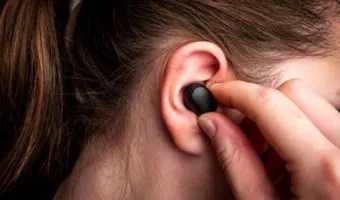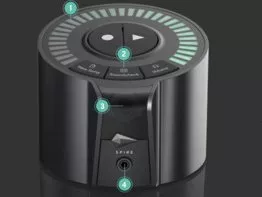The freedom wireless headphones and earbuds enable is unparalleled: No more untangling a jumbled mess of cords, no more accidentally yanking your headphones out of the jack when listening to your favorite song or podcast and no more lugging your device around with you as you walk around your house.
Whether you’re strolling around the city, joining coworkers on a video call or getting a sweat in at the gym, wireless earbuds and headphones are everywhere — and with many smartphones removing the audio port, there’s a good reason why. As the comfortability, durability, sound quality, connection stability and cost of true wireless earbud and headphone systems improve, users around the world increasingly covet wireless options for their flexibility and freedom of choice.
To gain a competitive edge in the nearly $25 billion global headphone and earbud market, brands must create truly wireless products that stand out from the 5,000 unique headphone/earbud offerings currently available in the U.S. Our client — a leading audio lifestyle brand — tapped our custom earbuds and headphones design expertise and status as a Qualcomm design partner to develop a wireless headphone system with a unique bass-boosting feature.
Using Qualcomm Parts To Develop Bluetooth Audio Products
Initially, we were tasked with developing two custom products from scratch: wireless earbuds and the previously mentioned wireless headphones with extra bass.
We began work on the two products in parallel. We started with Qualcomm dev kits and eventually moved to the client’s hardware. Our team was responsible for the initial hardware bring-up. While our client designed the earbud and headphone hardware in the project’s early stages, our team spent time on-site at the customer’s headquarters to bring up the hardware, firmware and software elements.
As a Qualcomm Advantage Network member, we have extensive experience with Qualcomm’s entire audio line. Our engineering team fills the gap by providing the audio engineering expertise necessary to integrate Qualcomm Bluetooth audio, Snapdragon and third-party parts into a customized solution that sets our customer’s product apart from competitors.
Designed for seamless audio quality, the wireless earbuds incorporate advanced Qualcomm technology, achieving efficient power management and crystal-clear sound — even on a bass codec with more than 100 coefficients.
For this project, we started with the following materials and customized the products with additional firmware and hardware features.
- Qualcomm sample applications
- The QCC5121 chipset (for the earbuds)
- The QCC5124 chipset (for the headphones)
- CSR8675 development boards
DevOps & CI
We didn’t only work on the product but also implemented continuous integration (CI) processes as part of the ongoing DevOps process. CI helps ensure we can reliably and repeatedly build and test applications.
Integrated Sensors
Since consumer audio products demand advanced features, we integrated various sensors (capacitive touch, accelerometer, proximity) to record touch/tap gestures, volume up/down and in-ear activation. Users needed to be able to adjust the volume up or down, tap to pause or skip tracks or make phone calls with the touch of a button, and these technologies enabled that functionality. We also needed to utilize a special audio processor/codec for bass enhancement and proximity sensors for in-ear activation.
Embedded Software Development
Additionally, we implemented the firmware for the earbuds charging case which used a one-wire interface to the earbuds to communicate charging status and in-case states. The case also had to have its own battery and charge separately. The headphones, on the other hand, required a “gauge” to monitor battery life.
Noise Cancellation & Voice Control
Both products feature LED status lights to communicate whether the device is charging, pairing, in noise-cancellation mode, searching, etc. Additionally, the devices needed to listen and respond to voice commands and tones.
Leveraging our deep audio engineering expertise, we built a development environment and the custom wireless headphone system from end to end. While the sensors, user interface design and third-party integration were complex, the most time-consuming effort involved perfecting the audio to meet the customer’s exacting standards. These included removing pops/hisses due to state transitions, verifying audio quality by tapping into internal audio signals, and customizing third party audio processor coefficient settings.
Enhanced Bass and Other Custom Audio Product Engineering Challenges Overcome
A significant challenge we faced during development was integrating the third-party bass-enhancing codec into the audio path.
Designed to allow users to experience an even broader range of deeper, richer bass, the custom headphones required a special processor for enhanced bass. Audio was routed from Qualcomm’s DSP (digital signal processor) to the codec and then remixed before reaching the headphone speakers.
 The bass may sound flat or of poor quality without tuning, even with a good codec and speaker. Since every speaker has its own frequency response, the codec should be tuned to the speaker characteristics, while considering the kind of audio that will be played and that bass will need enhancement.
The bass may sound flat or of poor quality without tuning, even with a good codec and speaker. Since every speaker has its own frequency response, the codec should be tuned to the speaker characteristics, while considering the kind of audio that will be played and that bass will need enhancement.
The bass codec saw more than 100 coefficients, with our team making many subtle changes to bass levels that could cause popping or buzzing in order to achieve natural sound. Complicating the issue, there wasn’t a test fixture for tuning — individual engineers listened to the music and waveforms going into the speaker, but that didn’t always reveal the anomalies. With careful analysis and application of filter settings, we ultimately created a clean-sounding, incomparable enhanced bass experience that end users increasingly crave.
Another challenge was the boot sequence, especially the sensor and external audio/codec initialization. The state machine needed to work on the boot sequence and involved complex pairing and role-switching scenarios with the earbuds. For example, if a user takes one bud out of the case and puts it in their ear and then puts the same bud down and uses the other bud to listen, the system must recognize when buds are in the case, set down or in the ear and react accordingly. Learn more about state machines in this blog post on domain-driven design for embedded systems.
Finally, our client initially committed to creating earbuds and headphones in parallel but only completed the custom headphones design. While the products had some shared drivers, the state machines for the two products are different since headphones don’t have in-case or in-ear mode. Furthermore, earbuds are more complex since the audio needs to be routed wirelessly to the two earpieces, as opposed to the wired connection of the headphone’s over-ear speakers, and the earbuds rely more on touch and accelerometer sensors since they didn’t have physical buttons.
Custom Headphones and Earbuds Design Lessons Learned
Our team performed all third-party integrations, updates and power usage measurements necessary to launch a world-class wireless headphone product. Third-party integrations included Google Assistant, Audiodo, Hearezanz, Tile™ and Apple MFi, while the headphones were designed for compatibility with iOS, Android and Bluetooth. Because optimizing earbud battery usage remains challenging, we used a power debug tool to test different earbud power modes against power consumption.
To ensure the creation of the highest-quality product that works as well as possible as often as possible, we owned quality assurance and extensively tested every feature of both products every step of the way to reduce uncertainty before launch.
After working with our client’s manufacturing partner to ensure successful shipping of the product, we stepped back to assess the project and highlight important takeaways for additional custom audio product development projects down the road.
Lesson 1: Developing Multiple Products in Parallel Can Be Risky
We started the development of both products in parallel, leveraging Qualcomm’s headphone platform for the headphones and Qualcomm’s earbud platform for the earbuds. However, trying to build both products simultaneously with one engineering team proved challenging and in the end, the customer prioritized the headphones and scaled back on the earbuds.
Lesson 2: Spend As Much Time On the Sensor System As Audio
If we were advising a client on a custom headphone or earbud design, we would recommend perfecting the sensor technologies to ensure the optimal experience. A user won’t care how incredible the audio sounds if effectively using the product is a headache.
Lesson 3: Auracast Offers an Advantage
Not applicable to this audio design project, but Auracast technology will make this type of effort easier in the future. The new Bluetooth capability can broadcast audio from a smart device straight to both channels (both earbuds) instead of a right earbud as primary and then that bud transmitting to the left bud in sync.
As a leading audio product design company, we advise clients to get maximum reuse for their designs with flexibility and success across devices with a base product design branch that forks off to meet each individual products’ needs. Otherwise, competing interests prevent reusable code base in the long term.
If you need help launching an inventive audio product — whether custom headphones, custom earbuds or another audio innovation — contact us for innovative audio product engineering expertise! Our team understands how to leverage Qualcomm components to help you create differentiated audio products in terms of performance, features and cost. Let us know how we can accelerate the development of your connected audio devices with our end-to-end design services.



